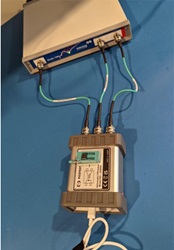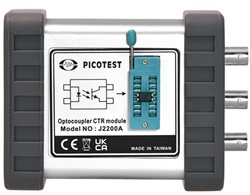The J2200A optocoupler test instrument provides various bias conditions for optocouplers and greatly eases the measurement of key parameters, including CTR. The J2200A provides pulse current mode measurement function, which reduces the temperature rise during the testing process improving the accuracy of the measurement. Optocoupler procurement is often exempted from incoming component inspection, but given counterfeit products are appearing in the market, optocoupler inspection has become more necessary. The J2200A is a very convenient tool for IQC.
The Optocoupler CTR Measurement Bundle includes the M3522A Digital multimeter. An ESSENTIAL part of performing the opto-coupler measurements. Togther they give you all the capability you need to quickly measure opto-coupler as shown in the above manuals, datasheet, and application note.
An optocoupler, also known as an opto-isolator or photocoupler, is an electronic component that allows electrical signals to be transferred between two circuits without a direct electrical connection. It consists of a light-emitting diode (LED) that is optically coupled to a photodetector, such as a phototransistor or a photodiode. When an electrical signal is applied to the LED, it emits light that is directed toward the photodetector. The amount of light received by the photodetector is proportional to the strength of the electrical signal, and this signal is then transferred to the output circuit. Because there is no direct electrical connection between the input and output circuits, the optocoupler provides electrical isolation, which can help protect sensitive electronic components from damage caused by voltage surges or other electrical disturbances.
Optocouplers are commonly used in electronic circuits for a variety of applications, including motor control, power supply regulation, and digital communications. They are particularly useful in situations where electrical isolation is required for safety reasons or to prevent interference between circuits. CTR stands for Current Transfer Ratio and is a parameter that describes the relationship between the input current and output current of an optocoupler or other similar devices. It is also sometimes referred to as the current gain.
The CTR is expressed as a ratio or percentage and is calculated by dividing the output current by the input current. For example, if an optocoupler has an input current of 10mA and an output current of 5mA, the CTR would be 50%. The CTR is an important parameter because it determines the efficiency of the optocoupler in transferring electrical signals between two circuits. A higher CTR means that more of the input current is transferred to the output, resulting in a stronger and more reliable signal. It also affects the speed and accuracy of the signal transfer, as well as the power consumption of the device.
It seems that engineers are facing a challenge in designing circuits using optocouplers, particularly on isolated feedback control circuits. The optocoupler's specifications provided by the manufacturer may not be sufficient as a reference for designing the circuit under current application conditions. Thus, engineers need to test the optocoupler under those conditions to obtain the corresponding parameters. Moreover, optocouplers come in different types, and the CTR rank is also varied, ranging from 50% to 600%. In addition, the manufacturer's specifications do not provide AC parameters such as ΔCTR and ΔRd, which are necessary for designing isolation feedback control circuits.
To address this issue, the J2200A is an essential tool for engineers in designing isolation feedback control circuits. It provides both AC and DC parameters of various bias voltages, making it easier for engineers to select and design the appropriate optocoupler for their circuit. However, this testing process may not be a one-time task since the optocoupler selection varies depending on the application, and engineers may need to test different optocouplers to find the most suitable one for their circuit design. The range of CTR specifications for optocouplers is also quite wide, varying from 50%~600% in some cases. Precision circuit applications may not be able to tolerance this deviation, especially since the nominal CTR is not defined.
 |
 |
 |
Key Features:
- Opto-Coupler Measurement: CTR (Current Transfer Ratio), ΔCTR, Vf and ΔRd, Saturation, Bandwidth
- Design Tool: Plug-and-Play testing for 4 and 6 pin opto-couplers
- Easy wiring and control
- Works with the M352XA 6 ½ Digit Multimeter (DMM) for high-speed control, test setup, and data gathering
- Works with the OMICRON Lab Bode 100 VNA for AC Gain and Phase measurements
Applications*:
- R&D Testing Speeds Opto Measurement
- IQC Inspection Testing
- Easy wiring and control
What's included:
- J2200A CTR Module
- M352XA DMM
- M352XA to J2200A connection cable
- 1 Year Warranty
